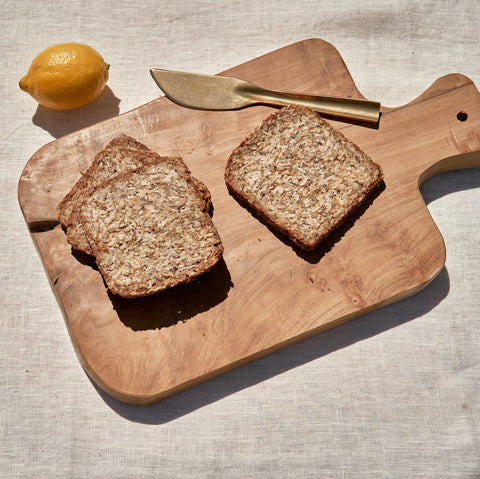
Discover the Health Benefits and Nutritional Value of Spelt | Gluten Alert
Share
What Is Spelt?
Spelt (Triticum spelta) is a type of ancient grain, often referred to as a "cousin" of modern wheat. Its origins can be traced back over 8,000 years to regions in Europe and the Near East, where it was a staple crop. Unlike heavily processed modern wheat varieties, spelt has retained much of its original structure and nutritional integrity. This resilience has made it a favored choice among those looking for less modified, more natural grain options.
One distinguishing feature of spelt is its tough outer husk, which protects the grain from pests and environmental damage. This husk must be removed before processing, a step that preserves much of the grain's nutrients. In modern times, spelt has been embraced for its nutty flavor, chewy texture, and versatility in both sweet and savory dishes. While less common than wheat, spelt is becoming increasingly available in health food stores and specialty markets.

Gluten in Spelt: What You Need to Know
Despite its many health benefits, spelt is not gluten-free. Gluten is a protein found in wheat, barley, rye, and their derivatives, including spelt. Its gluten content is slightly different from that of modern wheat, which may make it easier to digest for some people. However, this does not mean it is safe for individuals with celiac disease or non-celiac gluten sensitivity. Spelt should be avoided entirely by those with such conditions.
Interestingly, spelt's gluten composition gives it a more elastic quality, which can be advantageous in baking. It often yields softer, more tender bread and pastries compared to modern wheat. Still, this feature can be a double-edged sword, as spelt dough is more prone to over-kneading, which can lead to denser results. For those without gluten-related health issues, spelt offers a flavorful and nutritious alternative to heavily processed wheat products.
Nutritional Profile of Spelt
Spelt stands out as a nutrient-rich grain, offering a balanced mix of macronutrients and essential vitamins and minerals. A single serving of cooked spelt (approximately 1 cup or 194 grams) provides 246 calories, making it an excellent source of sustainable energy. Its 10.7 grams of protein per serving contribute to muscle repair and overall bodily functions, while its 7.6 grams of fiber promote digestive health and satiety.
The grain is also abundant in micronutrients. Manganese, which is crucial for bone health and metabolic regulation, makes up a staggering 106% of the daily value (DV) in one serving. Magnesium (27% DV) supports muscle and nerve function, while phosphorus (29% DV) plays a role in energy production and bone formation. Spelt's antioxidant content, including phenolic acids, adds an additional layer of health benefits, helping to combat oxidative stress and inflammation in the body.

How Spelt Compares to Other Grains
When compared to modern wheat, spelt has a more robust nutritional profile, offering higher levels of protein, fiber, and certain minerals like magnesium and zinc. It is also less processed than most modern wheat varieties, retaining more of its natural nutrients. Compared to rice, spelt offers significantly more fiber and protein, making it a more filling and nutrient-dense choice.
Gluten-free grains like quinoa and millet excel in amino acid content but may fall short in overall nutrient density when compared to spelt. Oats, another popular grain, are comparable in fiber content but lack the diversity of vitamins and minerals found in spelt. Ultimately, spelt serves as a versatile middle ground for those seeking a nutrient-rich grain that is easy to incorporate into various recipes.
Cooking and Baking with Spelt
Cooking with spelt is straightforward, but it requires some adjustments for optimal results. Whole spelt berries, for example, are best cooked using a 1:3 ratio of grain to water or broth. They should be simmered for about an hour until tender, and their nutty flavor makes them an excellent addition to salads, soups, and pilafs.
Spelt flour, on the other hand, is a popular choice for baking. It can replace all-purpose flour in most recipes but requires slight modifications. For instance, spelt dough tends to absorb less water and may spread more during baking, so reducing liquid or chilling the dough before baking can help maintain structure. Whether used in pancakes, bread, or cookies, spelt adds a rich, nutty flavor and a hearty texture to baked goods.

Spelt Sourdough Bread Recipe
This recipe combines the nutty flavor of spelt with the natural leavening of a sourdough starter. It's entirely vegan and perfect for a wholesome, homemade loaf of bread. The process is straightforward but requires some patience for the slow fermentation that makes sourdough bread so special. Please note this is not a gluten free recipe!
What you'll need:
- 3 cups (360g) spelt flour
- 1 cup (120g) whole wheat flour (optional, for structure)
- 1 cup (240g) active sourdough starter (100% hydration)
- 1 1/4 cups (300ml) water (lukewarm)
- 1 1/4 tsp sea salt
- 1 tbsp olive oil (optional, for a softer crust)
How to make it:
Step 1: Feed Your Sourdough Starter
Ensure your sourdough starter is active and bubbly before beginning. Feed it 4–6 hours before using, depending on its usual fermentation time, and let it sit at room temperature.
Step 2: Mix the Dough
In a large mixing bowl, combine the spelt flour, whole wheat flour (if using), and salt. In a separate bowl, mix the sourdough starter with the lukewarm water. Slowly pour the liquid mixture into the dry ingredients, mixing with a wooden spoon or your hands until a shaggy dough forms. If the dough feels too dry, add a tablespoon of water at a time until it comes together.
Step 3: Knead and Rest
Knead the dough gently for about 5 minutes. Spelt dough is more delicate than wheat dough, so avoid over-kneading to prevent it from becoming too dense. Cover the bowl with a damp kitchen towel and let it rest for 30 minutes.
Step 4: Stretch and Fold
To develop the gluten structure, perform a series of stretches and folds every 30 minutes for 2 hours. To do this, gently pull one side of the dough up and fold it over itself, rotating the bowl and repeating on all four sides. Cover the dough after each stretch and fold session.
Step 5: Bulk Fermentation
Cover the bowl with a damp towel or plastic wrap and let the dough rise at room temperature for 4–6 hours, or until it has doubled in size. Spelt ferments more quickly than regular wheat, so check frequently.
Step 6: Shape the Dough
Turn the dough onto a lightly floured surface. Shape it into a round or oval loaf by folding the edges toward the center and flipping it over. Place the shaped dough seam-side down in a floured proofing basket or bowl lined with a clean kitchen towel.
Step 7: Final Proof
Cover the dough and let it proof for another 1–2 hours at room temperature, or overnight in the refrigerator. A slower proof will enhance the sourdough flavor.
Step 8: Preheat the Oven
Preheat your oven to 475°F (245°C). Place a Dutch oven or baking stone inside to heat up for at least 30 minutes.
Step 9: Score and Bake
When ready to bake, carefully turn the dough onto parchment paper. Score the top with a sharp knife or lame to allow it to expand during baking. Transfer the dough (with parchment) into the preheated Dutch oven or onto the baking stone. Cover with the Dutch oven lid or a large baking pan to trap steam.
Bake for 20 minutes with the cover on, then remove the cover and bake for an additional 15–20 minutes, or until the crust is golden brown and the loaf sounds hollow when tapped.
Step 10: Cool and Enjoy
Remove the bread from the oven and let it cool completely on a wire rack before slicing. Cooling allows the crumb to set and ensures the best texture.
Tips for Success
- Adjust Hydration: Spelt flour absorbs water differently than regular wheat, so tweak the water quantity if needed.
- Monitor Proofing: Spelt dough ferments faster, so avoid over-proofing, which can lead to a dense loaf.
- Experiment with Add-Ins: Add seeds, dried fruits, or nuts to the dough for extra flavor and texture.
This spelt sourdough bread pairs beautifully with vegan spreads like avocado, hummus, or almond butter. Enjoy the rich, earthy flavor and the satisfaction of baking your own wholesome loaf!
A Note On Sourdough
Some people who avoid gluten have found they can tolerate sourdough bread, even when made with gluten-containing grains like spelt. The reason lies in the fermentation process. During sourdough fermentation, lactic acid bacteria and yeast partially break down gluten and other proteins, making the bread easier to digest for some individuals. These microorganisms also release enzymes that reduce certain compounds, such as FODMAPs, which can cause digestive discomfort in people with sensitivities.
However, while the gluten content is reduced, sourdough is not gluten-free, and individuals with celiac disease must still avoid it. For those with mild gluten intolerance or sensitivities, though, the fermentation process may make sourdough bread a more digestible option. Check with your healthcare provider before trying anything at home!
If you are 100% Gluten Free it doesn't mean you can't also enjoy some delicious homemade bread. Try out the recipe in our guide to gluten free bread.
Want delicious bread that's premade? Try Organic Pharmer's Gluten Free Pharmer Bread. 100% Organic, gluten free, vegan and highly nutritious.

Order Your Gluten Free Bread
Who Should Avoid Spelt?
While spelt is nutritious, it is not suitable for everyone. People with celiac disease should strictly avoid it due to its gluten content, which can trigger severe immune responses. Similarly, those with non-celiac gluten sensitivity may experience symptoms such as bloating, fatigue, and brain fog after consuming spelt.
Additionally, spelt is considered a high-FODMAP food, which means it contains fermentable carbohydrates that can cause digestive discomfort in individuals with irritable bowel syndrome (IBS). Consulting with a healthcare provider is essential if you suspect spelt may not align with your dietary needs.
Consider Trying Spelt
If your health permits and gluten is not a concern, incorporating spelt into your diet can be a rewarding and nutritious choice. This ancient grain offers a delightful combination of robust flavor, versatility, and essential nutrients like fiber, protein, and minerals that promote overall health. Whether used in baking, cooking, or as a hearty alternative to more processed grains, spelt provides a wholesome addition to meals. Its sustainability benefits also make it an eco-friendly option for conscientious eaters. As with any dietary change, it’s best to consult with a healthcare provider to ensure spelt aligns with your unique nutritional needs. Give spelt a try and savor its rich, nutty taste while reaping its numerous health benefits!
